
Concept explainers
(a)
Interpretation: The relationship between ![]() and
and ![]() is to be stated.
is to be stated.
Concept introduction: The anomers are cyclic monosaccharides, which differ in configuration at one stereogenic centre. These carbon atoms are called anomeric centre.
Answer to Problem 28.42P
The compounds ![]() and
and ![]() are epimers.
are epimers.
Explanation of Solution
The structures of compounds ![]() and
and ![]() are,
are,
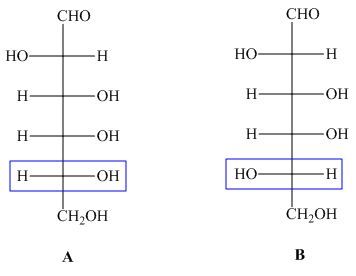
Figure 1
In the given structures, the configuration at ![]() is different. Hence, the compounds
is different. Hence, the compounds ![]() and
and ![]() are epimers.
are epimers.
The compounds ![]() and
and ![]() are epimers.
are epimers.
(b)
Interpretation: The relationship between ![]() and
and ![]() is to be stated.
is to be stated.
Concept introduction: The anomers are cyclic monosaccharides, which differ in configuration at one stereogenic centre. These carbon atoms are called anomeric centre. The compounds which are neither mirror images nor supperimposable on each other are known as diastereomer.
Answer to Problem 28.42P
The compound ![]() and
and ![]() are diastreomers but not epimers.
are diastreomers but not epimers.
Explanation of Solution
The structures of given compound ![]() and
and ![]() are,
are,
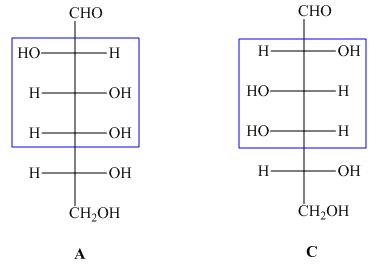
Figure 2
In the given structures, the compound ![]() is not mirror image of compound
is not mirror image of compound ![]() and the configuration of more than is different. Hence, the compound
and the configuration of more than is different. Hence, the compound ![]() and
and ![]() are diastreomers but not epimers.
are diastreomers but not epimers.
The compound ![]() and
and ![]() are diastreomers but not epimers.
are diastreomers but not epimers.
(c)
Interpretation: The relationship between ![]() and
and ![]() is to be stated.
is to be stated.
Concept introduction: The compounds which are mirror images as well as non-supperimposable on each other. These compounds are known as enantiomers.
Answer to Problem 28.42P
The compound ![]() and
and ![]() are enantiomers.
are enantiomers.
Explanation of Solution
The structures of given compound ![]() and
and ![]() are,
are,
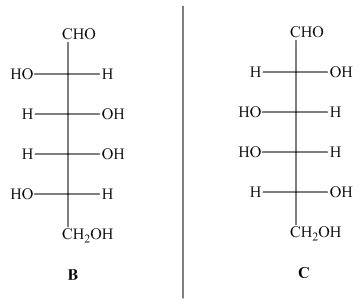
Figure 3
In the given structures, the compound ![]() is mirror image of compound
is mirror image of compound ![]() . Hence, the compound
. Hence, the compound ![]() and
and ![]() are enantiomers.
are enantiomers.
The compound ![]() and
and ![]() are enantiomers.
are enantiomers.
(d)
Interpretation: The relationship between ![]() and
and ![]() is to be stated.
is to be stated.
Concept introduction: The compounds which have same molecular formula but differ in connectivity of the substituents. These compounds are known as constitutional isomers.
Answer to Problem 28.42P
The compound ![]() and
and ![]() are constitutional isomers.
are constitutional isomers.
Explanation of Solution
The structures of given compound ![]() and
and ![]() are,
are,
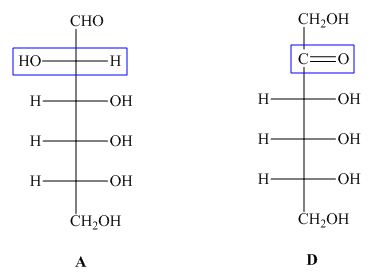
Figure 4
In the given structures, the molecular formula of ![]() is same to the molecular formula of
is same to the molecular formula of ![]() but the connectivity of substituents at
but the connectivity of substituents at ![]() is different. Hence, the compound
is different. Hence, the compound ![]() and
and ![]() are constitutional isomers.
are constitutional isomers.
The compound ![]() and
and ![]() are constitutional isomers.
are constitutional isomers.
(e)
Interpretation: The relationship between ![]() and
and ![]() is to be stated.
is to be stated.
Concept introduction: The anomers are cyclic monosaccharides, which differ in configuration at one stereogenic centre. These carbon atoms are called anomeric centre. The compounds which are neither mirror images nor supperimposable on each other are known as diastereomer.
Answer to Problem 28.42P
The compounds ![]() and
and ![]() are diastreomers but not epimers.
are diastreomers but not epimers.
Explanation of Solution
The substituents on a carbon are present above the ring in Haworth projection indicates that these bonds are above the plane (i.e. either equatorial or axial position) in chair form. The structures of given compound ![]() and
and ![]() are,
are,
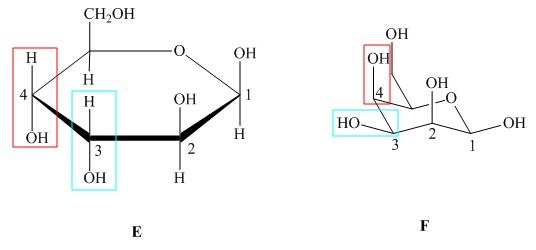
Figure 5
In the given structures, the configuration at ![]() is different which shows that the compound
is different which shows that the compound ![]() is not mirror image of compound
is not mirror image of compound ![]() and. Hence, the compound
and. Hence, the compound ![]() and
and ![]() are diastreomers but not epimers.
are diastreomers but not epimers.
The compounds ![]() and
and ![]() are diastreomers but not epimers.
are diastreomers but not epimers.
Want to see more full solutions like this?
Chapter 28 Solutions
PKG ORGANIC CHEMISTRY
- Predict the major products of this organic reaction: 1. LDA (-78°C) ? 2. Br Some notes: • Draw only the major product, or products. You can draw them in any arrangement you like. . • Be sure to use wedge and dash bonds where necessary, for example to distinguish between major products that are enantiomers. • If there are no products, just check the box under the drawing area. No reaction. Click and drag to start drawing a structure. Xarrow_forwardPlease draw the structuresarrow_forwardDraw the missing intermediates 1 and 2, plus the final product 3, of this synthesis: 0 1. Eto 1. Eto- 1 2 2. MeBr 2. EtBr H3O+ A 3 You can draw the three structures in any arrangement you like. Explanation Check Click and drag to start drawing a structure.arrow_forward
- Draw the missing intermediate 1 and final product 2 of this synthesis: 1. MeO- H3O+ 1 2 2. PrBr Δ You can draw the two structures in any arrangement you like. Click and drag to start drawing a structure.arrow_forwardWhat is the differences between: Glyceride and phosphoglyceride Wax and Fat Soap and Fatty acid HDL and LDL cholesterol Phospho lipids and sphingosine What are the types of lipids? What are the main lipid components of membrane structures? How could lipids play important rules as signaling molecules and building units? The structure variety of lipids makes them to play significant rules in our body, conclude breifly on this statement.arrow_forwardWhat is the differences between DNA and RNA for the following: - structure - function - type What is the meaning of: - replication - transcription - translation show the base pair connection(hydrogen bond) in DNA and RNAarrow_forward
- What is the IP for a amino acid- give an example what are the types of amino acids What are the structures of proteins The N-Terminal analysis by the Edman method shows saralasin contains sarcosine at the N-terminus. Partial hydrolysis of saralasin with dilute hydrochloric acid yields the following fragments: Try-Val-His Sar-Arg-Val His-Pro-Ala Val- Tyr- Val Arg-Val-Tyr What is the structure of saralasin?arrow_forwardWhat is the IP for a amino acid- give an example what are the types of amino acids What are the structures of proteins The N-Terminal analysis by the Edman method shows saralasin contains sarcosine at the N-terminus. Partial hydrolysis of saralasin with dilute hydrochloric acid yields the following fragments: Try-Val-His Sar-Arg-Val His-Pro-Ala Val- Tyr- Val Arg-Val-Tyr What is the structure of saralasin?arrow_forward> aw the missing intermediates 1 and 2, plus the final product 3, of this synthesis: 1. Eto 1. EtO¯ H3O+ 1 2 2. PrBr 2. PrBr Δ You can draw the three structures in any arrangement you like. 3 Click and drag to start drawing a structure. Explanation Check 2025 McGraw Hill LLC. All Rights Reserved. Terms of Use Privacarrow_forward
- There are various factors that affect an equilibrium. Give 3 of these factors and explain using examples andequations how an equilibrium is affected by these factors. Please remember that this is a communication question so that you are communicating your understanding of the factors that affect and equilibrium.arrow_forwardEEZE LETCHUP ID Draw the most likely conjugate base resulting from this acid-base reaction. Include all lone pairs. Ignore inorganic byproducts. Drawing く NaOCH2CH3 :0: :0: 狗arrow_forwardAnswerarrow_forward
 Organic Chemistry: A Guided InquiryChemistryISBN:9780618974122Author:Andrei StraumanisPublisher:Cengage Learning
Organic Chemistry: A Guided InquiryChemistryISBN:9780618974122Author:Andrei StraumanisPublisher:Cengage Learning Chemistry for Today: General, Organic, and Bioche...ChemistryISBN:9781305960060Author:Spencer L. Seager, Michael R. Slabaugh, Maren S. HansenPublisher:Cengage Learning
Chemistry for Today: General, Organic, and Bioche...ChemistryISBN:9781305960060Author:Spencer L. Seager, Michael R. Slabaugh, Maren S. HansenPublisher:Cengage Learning


